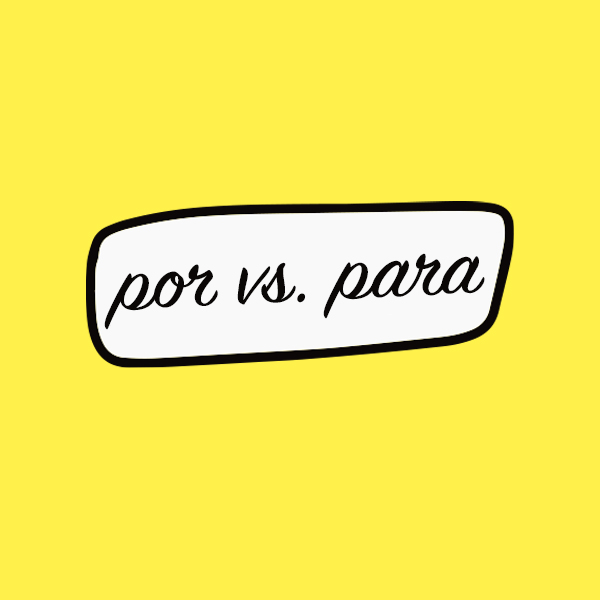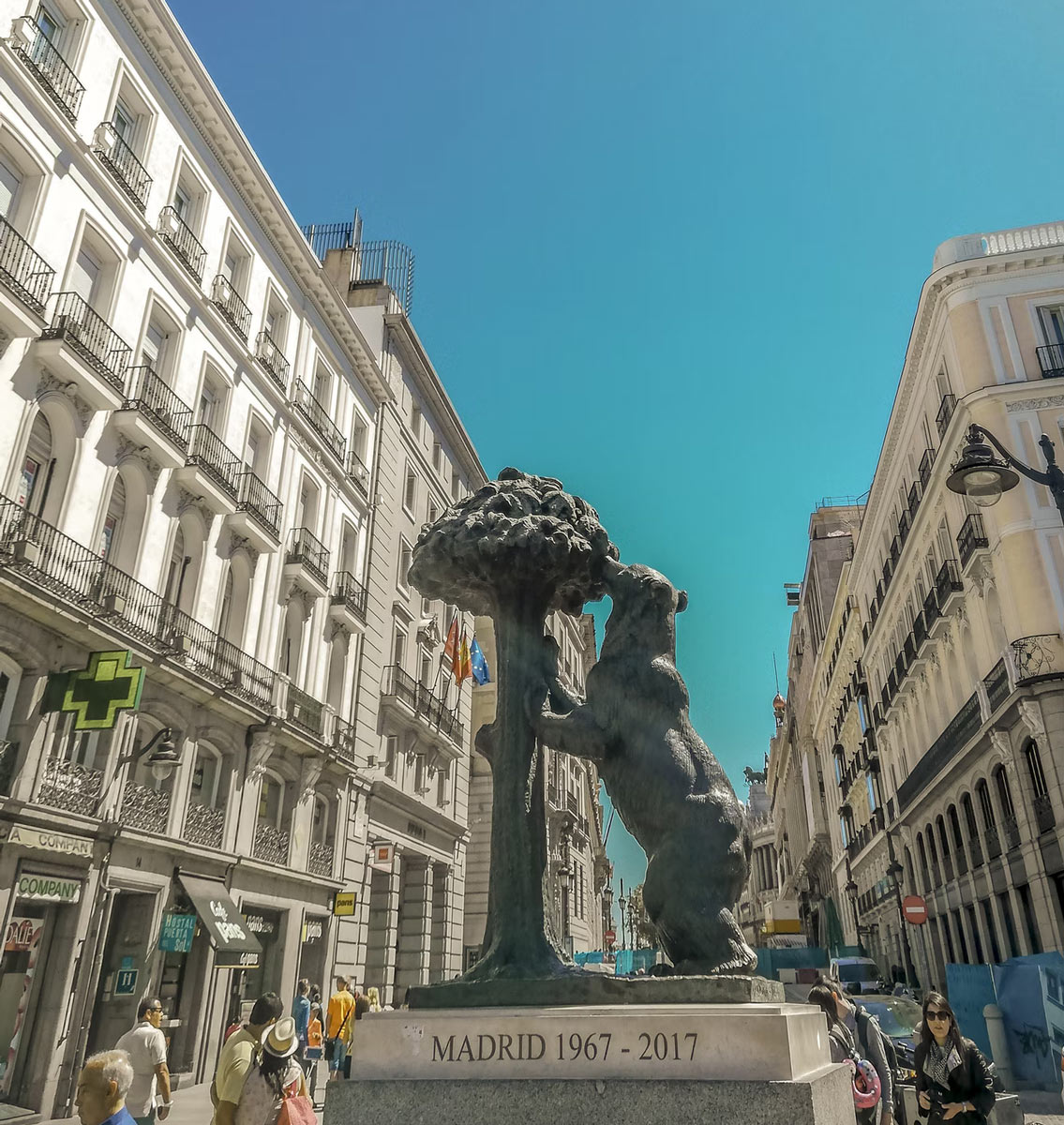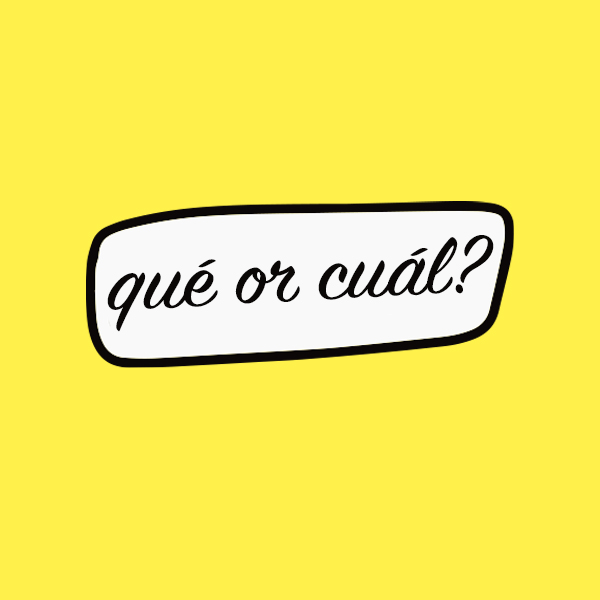Por vs Para: Which one to use?
This is a custom heading element.
Sometimes, learning Spanish is a piece of cake (está chupado), and on other occasions there are bits of grammar which can seem like a real headache. Por and para are two tiny words which can, at first, seem very confusing, but once you get the hang of how to use them they are extremely useful. I know when I first starting studying Spanish I used to get into a bit of a mess with which one to use, but to be fair, native speakers are always sympathetic with language learners and will attempt to understand through the context.
Por or para? The eternal question
Both por and para can be translated as for in lots of situations, but they can mean many other things as well. They are used in a lot of expressions, verb structures and as prepositions with particular times as well as in a myriad of other structures. When deciding which one to use, it’s important to think about the meaning of the whole phrase you want to say and not translate word for word. When learning any language, individual translations often don’t help you construct real phrases. The best way to help you see the difference is through examples. Take a look at the tables below to get a better feel for these important words.
Uses of ‘para’
| Spanish | English | Reason |
| Es para ti | It’s for you | Destination (e.g. of a gift) |
| Estoy ahorrando para comprar un coche | I’m saving to buy a car | Purpose (e.g. in order to) |
| Juan va para la casa de su amiga | Juan is going to his friend’s house | Intention/Destination (e.g. of movement) |
| Tengo que estar en la fiesta sorpresa para las 6 de la tarde | I have to be at the surprise party by 6pm | With time phrases |
| La silla es para sentarse, no para poner los pies | The chair is for sitting on, not for putting your feet on | An object’s use or purpose |
| Estamos para salir | We’re are about to go out | “Estar para” means “to be about to” |
Uses of ‘por’
| Spanish | English | Reason |
| Hablo con mi madre por teléfono todos los días | I speak with my mum by phone every day | How you communicate with someone |
| El metro no pasa por mi barrio | The metro doesn’t go through/via my neighbourhood | Moving “through” somewhere |
| Olvidé hacerlo por no apuntar la tarea en mi lista | I forgot to do it because I didn’t write the task on my list | The cause or reason for an action |
| Me gusta tomar un vermut por la tarde | I like to have a vermouth in/during the afternoon | General time meaning “during” |
| Te doy 10 euros por el libro | I’ll give you 10 euros for the book | An exchange |
| Comer por comer | Eat for the sake of it | Translates as “for the sake of” |
The tables above give you some clear examples of how to use these important prepositions. When learning Spanish, you really should try to speak as much as possible and practise using them through trial and error. Nobody ever got better at anything without making a few (or lots of!) mistakes along the way. It’s vitally important that you get into the habit of writing down new examples of language as you see and hear them so that you can incorporate phrases into your own speech and writing. Both por and para appear all the time in Spanish and so you’ll have plenty of chances to use them and hear them used.
Little by little (poco a poco) you’ll become more fluent in Spanish by just trying your best and giving it a go.
To learn more about por and para, as well as all other aspects of Spanish language and culture, come join us here at Hablamos – you won’t regret it!
Top 5 things to do in Madrid
This is a custom heading element.
Studying Spanish in Madrid is an absolutely fantastic idea – we obviously all think it is at Hablamos or we wouldn’t all be here! Not only do you get the chance to speak Spanish with millions of people, but also you have an enormous range of activities to immerse yourself in Spanish culture.
1. Eat a bocadillo de calamares in Plaza Mayor
This ranks as one of the most madrileño things you can possibly do. But what is a bocadillo de calamares you might ask? Well, it’s a baguette with deep-fried squid rings! Honestly, they’re delicious, and you can water it down with a caña de cerveza (a small beer) or two while sitting in the famous Plaza Mayor. This square, in the heart of the city, dates back to the late 16th century and has always been at the centre of Madrid life. It was used as a place to hold inquisitions, bullfights, public hangings, official events, you name it! Nowadays it’s a tourist attraction and is full of bars and restaurants for you to enjoy the city’s culinary delights.
2. Take a stroll around the Parque del Buen Retiro
Another area of the city worth a trip to is the Parque del Buen Retiro, or El Retiro for short. This 5.38 km2 park located east of the city centre is perfect for an afternoon paseo (stroll/walk) once you’ve had some tapas (small plates of food) and enjoyed a little siesta (nap). The site of an old palace, the park features a beautiful boating lake, a couple of exhibition halls belonging to the nearby Museo Reina Sofia and abundant green spaces where you can chill out after a hard day learning Spanish. Locals flock to the area at weekends, but during the week it’s nowhere near as busy.
3. Visit Goya and Velázquez in the Museo del Prado
An unmissable stop on any visit to Madrid is the Museo del Prado. This enormous art gallery is filled with paintings by great artists such as Goya, Velázquez and the ahead-of-time El Greco. While you’re in Madrid studying Spanish, you’ll probably have time to visit more than once as there’s far too much to take in on one day. Given the immensity of the museum, we’d recommend getting an audio guide to help take you around and also practise your Spanish listening skills at the same time. As well as having an incredible selection of paintings, El Prado also hosts a collection of ancient Greek and Roman sculptures and the Tesoro del Delfín which is a collection of various beautiful objects collected by the son of the French king Louis XIV. Check it out on your visit!
4. Take a tour of Real Madrid’s stadium
Madrid is home to two of Spain’s greatest football teams – Real Madrid and Atlético de Madrid. Both are in the top flight of Spanish football, but (even though Atleti fans don’t like it!) it’s Real Madrid who have won, by far, most championships and cups in their 120 year history. The Bernabéu stadium is home to these sporting legends, and has its own museum detailing all the past glories of the club. You can see their 14 European Championship cups, 34 La Liga (league) trophies and many more. The tour starts in the museum area, but visitors are also treated to a trip to los vestuarios (changing rooms) and el campo (the pitch). You can even sit on el banco (the bench) where the substitutes wait to go on the field! Any sports fan learning Spanish in Madrid has to go on the tour, and we’d also suggest going to un partido (a match) or two while you’re here as well!
5. Take a selfie with el oso y el madroño in Puerta del Sol
If you’ve ever looked for information about Madrid online, you’re sure to have seen the famous el oso y el madroño (the bear and the strawberry tree) which is one of the most emblematic symbols of the city. The legend goes that King Alfonso XI was out hunting on the outskirts of the city in the 14th century and captured a large bear. He was so impressed with the animal that he decided to include an image of it on Madrid´s heraldic shield! The origin of the madroño revolves around a political dispute between the Ayuntamiento de Madrid (Madrid city council) and the Church in 1222 over which areas of land they both controlled. The madroño tree was included on the city’s shield as a sign of the agreement reached between the two parties. Curious, right? Nowadays, a statue of this symbol of Madrid proudly stands in Puerta del Sol, another square right in the middle of Madrid. Tourists and locals queue to snap a selfie with this famous landmark, and it makes a great recuerdo (souvenir) of your time studying Spanish here in the capital.
Looking forward to seeing all these sights? Then come and join us here at Hablamos and start one of our Spanish courses today! There’s plenty more to see in beautiful Madrid, so what are you waiting for?
Let's talk about sport in Spanish!
This is a custom heading element.
Want to play a bit of fútbol? Fancy a quick round of golf? If you understand both of those words in bold, you already know a bit of Spanish vocabulary about sports. It’s actually incredibly easy to learn Spanish words for different sports as an English speaker, as a lot of them are very similar with pretty much no falsos amigos (false friends) to worry about. Here are just a few:
| Spanish | English |
| El fútbol | Football |
| El golf | Golf |
| El baloncesto | Basketball |
| El tenis | Tennis |
| El voleibol | Volleyball |
| El hockey | Hockey |
Let's construct a sentence with the verb jugar (to play)
That’s easy, isn’t it? Now we just need to construct a sentence to say which of these sports you actually play, and for that we need the verb jugar (to play). This verb has a stem change in that the “u” becomes “ue” when we use it to talk about certain people. Let’s have a look at what that means:
- I play = Juego
- You play (singular) = Juegas
- He/she plays = Juega
- You play (plural) = Jugáis
- We play = Jugamos
- They play = Juegan
Then, to make a full sentence with this verb, we always add a + noun and now we can start having a proper conversation! If I want to say I play football I should say Juego al fútbol. Or, if I’m talking about my friend Juan, then I would say Juan juega al fútbol. Simple! But, not all sports are “played” obviously, and so we need to learn some other verbs to expand our vocabulary.
| Spanish | English |
| Practicar | To practise/do |
| Hacer | To do (in this case anyway!) |
Both of these verbs can be used with different sports to give us the chance to speak about many more activities. For instance:
- Hago/Practico boxeo = I do boxing
- Hago/Practico natación = I do/go swimming
- Hago/Practico bicicleta = I do/go cycling
Once we’ve established which sports we do, maybe you’d like to tell people how often you do things. Again, this is fairly straightforward in Spanish as you simply say how many veces (times) per day/week/etc. So, I can say Juego al baloncesto dos veces al día/a la semana/al mes/al año which means I play basketball twice a day/week/month/year. You can simply swap out the word dos for any other number you like.
So, to sum up so far, we can now say which sports we play or do and how often we do them. It might be useful at this point to also mention how we can ask other people for this same information. Here are the questions you’ll need to start chatting about sport with your Spanish-speaking friends:
- ¿Qué deportes haces? = Which sports do you do?
- ¿Con qué frecuencia los haces? = How often do you do them?
Try and get speaking to some native Spanish speakers, or your classmates on your course at Hablamos about which sports they like to do and when!
Vocabulary for different sports
You might also like to know some specific vocabulary for different sports, so here are some lists of the most common words for a variety of activities. Why not try using them next time you’re out and about to strike up a conversation?
El fútbol – Football
| Spanish | English |
| Marcar un gol | To score a goal |
| El golaveraje | Goal average |
| El árbrito | Referee |
| El delantero | Striker |
| El centrocampista | Midfielder |
| El defensa | Defender |
| El penaltí | Penalty |
| El campo de fútbol | Football pitch |
El tenis – Tennis
| Spanish | English |
| La pista de tenis | Tennis court |
| La pista de hierba | Grass court |
| La raqueta | Racket |
| La pelota | Ball |
| La red | Net |
| El árbrito | Umpire |
| El saque | Serve |
| El jugador | Player |
El golf – Golf
| Spanish | English |
| El campo de golf | Golf course |
| El palo de golf | Golf club |
| El hoyo | Hole |
| Golpear la pelota | Hit the ball |
| Un hoyo en uno | A hole in one |
| La bandera | Flagstick |
| Una vuelta | A round |
| La puntuación | Score |
La natación – Swimming
| Spanish | English |
| La piscina | Pool |
| Estilo libre/crol | Freestyle/front crawl |
| El estilo espalda | Breastroke |
| El estilo mariposa | Butterfly |
| El salto | Dive |
| El fondo de la piscina | Bottom of the pool |
| Un largo | A length |
| El flotador | Armband |
And there you have it – a guide to how to start speaking in Spanish about sports and some useful vocabulary for when you’re learning how to read and listen in Spanish to information about different activities.
Why not try to get talking with some Spanish speakers about this interesting topic to practise your speaking skills? Also, come to Hablamos and we’ll teach you tons of useful vocabulary for this and many more topics!
What's so different about Spain Spanish and Latin American Spanish?
This is a custom heading element.
Spanish, that global language spoken by over 500 million people, isn’t as homogenous as you might think. Just like with English, the language has evolved in different ways depending on the country you’re talking about. Fancy a zumo de naranja or a jugo de naranja? Well, actually they’re the same thing (an orange juice just in case you didn’t know) and that’s just one of a multitude of examples we’re about to show you!
Studying Spanish in Spain, you’ll learn words like bolígrafo or boli for pen, whereas in most of Latin America this would be called a pluma, which incidentally means fountain pen in Spain. To be honest, you’ll be understood in any Spanish speaking country using either term, as in today’s globalised world, everyone is exposed to a multitude of cultures and linguistic differences. The same can’t be said for the phrase coger el tren/bus, which means take the train/bus here in Madrid and the rest of the country. Be very careful about saying this in Latin America, where the normal term is tomar el tren/bus, as the version from Spain means you’d like to have some intimate relations with that vehicle! Bit of a weird difference, right? Here are a few more ones to watch out for when travelling around the Spanish-speaking world:
| Spain | Latin America | English |
| Móvil | Celular | Mobile phone |
| Ordenador | Computadora | Computer |
| Coche | Carro | Car |
| Conducir | Manejar | To drive |
| Palomitas | Pororó | Popcorn |
Differences in pronunciation
Not only are there differences in terms of vocabulary between Spain and its Latin American cousins, there are also several changes in pronunciation. The biggest difference when listening is the sound of the letters “c” and “z” when they come before “e” or “i” as in cielo (sky). Over here in Spain, this word starts with a clear “th” sound like in the word think, whereas someone from Chile, for example, would use a “s” sound as in the word song. Having said that, there are certain accents in Spain which also use this pronunciation at times, mainly in the Canary Islands but also in parts of Andalucía. This one tiny sound can change the whole rhythm of a Spanish sentence as it is extremely common, as well as having an effect on certain wordplays. Take, for example, the following sentence:
“Vamos a cazarle, cazar con una zeta.” – We’re going to hunt him, hunt with a zed.
This sentence is a line from a famous Mexican telenovela (soap opera) and it only works as a play on words if you use Latin American pronunciation. Let me explain. Cazar (to hunt) and the word casar (to marry) only sound the same in Latin America, and the character was trying to emphasise that she wasn’t going to marry the guy who’d just been trying to chat her up, but destroy him as he was also ruining the life of her family through some dodgy business dealings. If that sounds a bit far-fetched, I recommend you go and practise your listening skills by watching any of the myriad of telenovelas now available online. You’ll soon find that this sort of thing is a common plot!
Beyond this, the differences in pronunciation between the different variants of Spanish mean you should always try to listen to a range of accents when learning to understand native speakers. There’s no use in always focusing on just Spain Spanish or Latin American versions otherwise you’re missing out on a vast amount of cultural knowledge and meeting some really interesting people.
And what about the grammar?
Another aspect of Spanish which is worth mentioning is the grammar, as here too there are some elements which differ depending on where you are in the world. One of the main differences is in the use of the vosotros form of a verb in Spain to refer to you in plural (as in a group of people) in a more informal way. This is standard when you’re speaking to a group of people you know well, like friends, or a teacher to their students. The formal version of this, for Spaniards anyway, is ustedes which for anyone from a Latin American country is the normal form for both formal and informal situations. Something else you’ll hear used differently are the past tenses. To refer to something that has happened today/this week/this month/etc, in Spain you’d hear something like “hoy he trabajado siete horas” (today, I’ve worked seven hours) which is the equivalent of the present perfect. A Columbian person, for instance, would use the past simple and say “hoy trabajé siete horas” (today, I worked seven hours).
Making sure you use the right words in the right countries is important when learning Spanish, as with any other language, as it clearly shows you’re interested in and aware of cultural differences. It’s a sign of respect, and means you’ll be more easily able to communicate on your travels.
Come join us on one of our Spanish courses here at Hablamos - we're waiting to teach you all about these differences and to help you make yourself understood wherever you go in the Spanish-speaking world!
Why learn Spanish in Madrid?
This is a custom heading element.
Madrid, the capital of Spain and one of the best cities to live in the world. These are just five of the many reasons why coming to study Spanish in Madrid is a great idea. Let’s look at each of them in turn.
World-class museums
No matter what sort of museum you’re into, Madrid has something for everyone. The famous Prado museum caters for those fans of such artists as Velázquez, Goya and the ahead of his time El Greco. You could easily spend half a day wandering the vast corridors of this palatial building and still not discover all of its secrets. However, if classical art isn’t your thing, then the Reina Sofia with its impressive collection of contemporary art might be more up your street. Picasso’s Guernica is the star painting here and hangs proudly alongside works from other great artists such as Miró, Dalí and Juan Gris.
“But I don’t like art”, you might say. Never fear- Madrid has plenty of other museums such as the Museo del Traje, Museo de América, Museo de Ciencias Naturales and many more. You’d be hard-pressed not to find something you’ll like!
Fantastic nightlife and cultural activities
Madrid has some legendary nightclubs, some of which are a holdover from the Movida Madrileña of the 1980s. The massive Kapital in the city centre is a seven-storey (yes, seven!) mega club, while Penta in trendy Malasaña plays all the best hits from the 80s and 90s. A big advantage of getting out and about in the evening is that you’ll come into contact with lots of locals to practise your Spanish with!
If clubbing isn’t your cup of tea, then there are lots of other ways to soak up the cultural atmosphere of Madrid. Like the theatre? Well, Gran Vía, one of the main boulevards in the city, has tons of theatres where you can enjoy the biggest musicals and productions. You could also take a food and drink tour, which is another great way of picking up some basic Spanish vocabulary too, or take in the breath-taking views from one of the multiple miradores in the city such as the Faro de Moncloa or at Centro Centro.
Excellent restaurants
Being the capital of Spain, Madrid has a wide range of culinary delights to sample while you immerse yourself in Spanish culture and learn its beautiful language. An unmissable place to go is Botín which holds the Guiness World Record for being the oldest continuously operating restaurant in the world- it opened in 1725! More relaxed options include the myriad of tapas bars dotted throughout the city where you can snack on some fantastic mini portions of Spanish cuisine while having a glass of locally produced wine.
Although the Madrid restaurant scene is a feast for the belly, you might sometimes want some home comforts in between your Spanish classes. Madrid now has a vast range of international options, from Thai to Colombian and even good old British fish and chips. It’s all a question of getting out into the city and exploring, all the while practising your Spanish conversational skills to get tips from the locals on the hottest new restaurants!
Great outdoor spaces
Nature lovers are spoilt for choice in Madrid as the city and its surroundings have some great green spaces to enjoy when you’re not studying. Right in the city centre is the Parque del Buen Retiro with its beautiful lake, shady grassed areas and remnants of the old palace buildings which used to dominate the area. Furthermore, the vast Casa de Campo on the eastern edge of the city has a fantastic cable car which takes you right into the heart of the park where you can enjoy some incredible views back over Madrid.
When you come to learn Spanish in Madrid, you shouldn’t forget that the city is surrounded by mountainous areas such the Sierra de Guadarrama which is absolutely perfect for hiking and climbing enthusiasts. The nearby countryside is dotted with quaint little villages full of history and beautiful architecture, such as the fortified buildings in Buitrago del Lozoya or the 15th century castle in Manzanares El Real.
Brilliant language schools
Evidently, the most important thing to anyone wanting to study Spanish in Madrid is the quality of the city’s language schools. It’s crucial that you find a school which offers top-quality teaching, great support for students and a range of courses to help you develop your Spanish language skills. With over 30 years’ experience teaching languages, Hablamos is the place for you. Our teachers are highly-qualified and use the latest teaching methods in class to make sure you develop the skills you need to get out into Madrid and confidently start talking to people from the very first lesson. You’ll soon be making lots of new friends and wondering why you didn’t make the move sooner!
What are you waiting for? Contact Hablamos now to reserve your place on one of our Spanish language courses and start enjoying all Madrid has to offer!
Which is right- qué or cuál? How to tell the difference!
This is a custom heading element.
When you started learning Spanish, you probably realised quite quickly that you needed to ask a lot of questions – ¿Cómo te llamas?, ¿Qué te gusta hacer? and many more. One thing you might (not!) have noticed is how the Spanish equivalents of what and which work differently. To ask for someone’s address, do you say ¿Qué es tu dirección? (What is your address?) or ¿Cuál es tu dirección? (Which is your address?). It’s ¿Cuál es tu dirección? Confused? – you won’t be after reading the rest of this blog!
Question words are basic Spanish vocabulary that you need to know, and so it’s important to get them right when speaking and writing. Let’s take a look at some points you need to bear in mind when using qué and cuál. Both of these can be translated as what and which depending on what we are trying to say. Here are some quick and easy rules as to when to use each word:
When we want to say "what"
- Qué is used to ask for definitions, time and explanations
- Cuál is more often used for asking for personal information
When we want to say "which"
- Qué can be used to ask about objects and personal preferences
- Cuál is used to ask someone to make a choice or pick from various options
Easy, right? No? Well here are some examples to give you a clearer idea
| English question | Spanish question |
| What do you want to eat? | ¿Qué quieres comer? |
| What time is it? | ¿Qué hora es? |
| What’s your address? | ¿Cuál es tu dirección? |
| What’s your favourite colour? | ¿Cuál es tu color favorito? |
| Which phone do you have? | ¿Qué móvil tienes? |
| Which museum in Madrid is the most interesting? | ¿Cuál es el museo más interesante en Madrid? |
| Which are the best restaurants in Madrid? | ¿Cuáles son los mejores restaurantes en Madrid? |
You might have spotted in the last example that cuál has changed to cuáles. Why is that? Simple – it’s because restaurants is in plural. We always have to use cuál for singular nouns, and cuáles for plural nouns. Let’s take a look at a couple of other examples using cuál and cuáles.
| Cuál | Cuáles |
| ¿Cuál es tu bolígrafo? – Which is your pen? | ¿Cuáles son los hijos de Paula? – Which ones are Paula’s children? |
| ¿Cuál es tu coche? – Which is your car? | ¿Cuáles son los peores hoteles en Madrid? – Which are the worst hotels in Madrid? |
So, to sum up, the main points to remember are that both qué and cuál can be translated as which and what depending on the question you’re trying to form. Knowing the difference means thinking carefully about the type of information you’re asking for, and you need to make sure that you use cuáles when talking about plural forms.
If this doesn’t all make sense yet then don’t worry. Taking a course here at Hablamos will help you to understand and speak Spanish in record time. Asking questions is one of the first things we learn in any new language, and our teachers will give you all the right tools to make yourself understood whatever the situation.
As with anything when studying Spanish, the best way to improve is to practise by having lots of conversations and speaking with as many people as you can. You might not get it right every time, but here in Madrid, people are very forgiving and just love to hear foreigners making an attempt to speak their language. When you come to study or live here, make sure you get out and about as much as possible. You’ll soon find yourself making loads of new friends with your beautifully formed Spanish questions.







